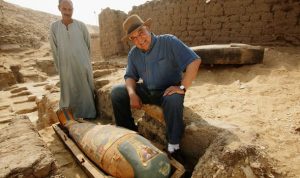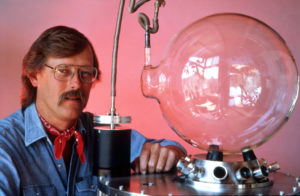Famed Egyptologist Zahi Hawass shares secrets from the sand.
“Today, I opened a shaft and found a sarcophagus with a mummy covered with gold,” said this larger-than-life and fantastically theatrical archaeologist last December during an ordinary Zoom call. And that’s what most have come to expect from an encounter with Hawass, anything but ordinary.
“This was in an area that was in the shadow of the Step Pyramid, the oldest pyramid in Egypt, with beautiful statues and a sealed sarcophagus of a lady covered with gold,” he explained. “We are in the process of discovering a new pyramid in the site. A month ago, we found the brother of King Tutankhamun. I found intact tombs that I did not open yet. We expect to be excavating in the Saqqara necropolis in September and hope to open these tombs.”
Likely coming straight from the site with news of great findings, Hawass will share his adventures, passion for discovery, and advocacy for conservation with audiences at two events: the first, Friday, Sept. 23 at the Flagstaff Festival of Science W. L. Gore & Associates Keynote Presentation at Northern Arizona University; the second, Sunday, Sept. 25, at the Flagstaff Dark Skies Coalition’s destination event at Arizona Nordic Village.
With discoveries in the global spotlight for more than three decades, Hawass is credited with bringing Ancient Egypt into our homes and hearts. The passion began in the 1980s. As the inspector of antiquities at the time, he was sent out to an excavation site. “I was unhappy to leave Cairo and go into the desert, but one day I found a tomb with the statue of Aphrodite, the goddess of beauty and love. While cleaning the statue, I found my love.”
In 1990, as director of Giza and Saqqara, he made a breakthrough discovery that determined the Pyramids were built by workers, not slaves. His findings uncovered an ancient cemetery near the Sphinx containing 600 graves and 50 larger tombs belonging to the builders of the pyramids and their families. His discoveries also include the Valley of the Golden Mummies at Bahariya Oasis.
Through years of excavating tombs of spectacular treasures and temples to the gods, following hidden passageways, carefully transferring mummies and decoding ancient writings, he says “the afterlife built Egypt,” a place that begins with nightfall for the deceased, filled with gods, strange creatures, gatekeepers and riddles solved through the Book of the Dead.
He has become comfortable with being lowered into deep, dark, tight shafts, squeezing between massive slabs of granite, coming into contact with deadly cobras and facing superstitions surrounding the fabled “curse” of the pharaohs. He recalls looking through the slit of a hidden door and peering straight into the gleaming crystal eyes of a statue that had been sealed in a tomb for thousands of years. “I cannot describe what this is like. You can only know by experiencing it.”
Since 2011, Hawass has served twice as Egypt’s Minister of Antiquities, arguably the most powerful archaeology job in the world. He has taught students in universitas and educated the public through many film and television programs and news reports.
Today, he is leading teams of archaeologists on expeditions in search of the tomb of Imhotep, believed to be the builder of the Step Pyramid, in Saqqara, and Queen Nefertiti’s tomb in Luxor. She is often referred to as King Tut’s mother, however she was actually his stepmother. “We have tombs of queens with names and tombs of queens with no names,” he said, explaining that advanced technology will help identify royal family members as well as more private ancient Egyptian citizens.
In 2020, Hawass announced the discovery of the Lost City of Luxor, a network of mud brick walls, neighborhoods, a cemetery and work spaces for preparing food, making bricks and crafting jewelry, offering a glimpse of what life was like 3,500 years ago. The lost city, used by the boy ruler King Tut, is considered to be the most important discovery about Ancient Egypt since the young pharaoh’s tomb was found by British archaeologist Howard Carter on Nov. 4, 1922.
To honor the centennial of this landmark moment in Egypt’s long history, Hawass will headline a conference on Nov. 4, with hundreds of scholars at the Grand Egyptian Museum on the Giza Plateau outside of Cairo, where he serves on the Board of Trustees. This is where he hopes to announce the truth behind King Tut’s death at age 18.
Marking the 200th anniversary of the discovery of the ancient Egyptian language, the Grand Egyptian Museum is expected to open to the public next year, said Hawass, the world’s leading expert in Egyptian hieroglyphics.
“A big statue of Ramesses II will receive everyone. The staircase with 100 kings of Egypt will lead to two galleries and a children’s museum. It’s going to be a big thing. The Egyptian government is really keen on preserving Egyptian monuments, opening the museum and implementing the big important conservation plan happening in Egypt now, starting with the excavation of the Valley of the Kings, the search for the tomb of Queen Nefertiti, and continuing the excavation of the golden city.” he said. “You can now walk between the Pyramid site and the Grand Museum. We are also opening an airport 20 miles from Giza to make travel for visitors more convenient.”
Hawass says global interest in Ancient Egypt has exploded with news of recent discoveries. “Modern technology, like CT scans, 3D LiDAR and DNA testing, has been really important to upgrade our knowledge. Without this, we would not be able to continue the excavation in the Valley of the Kings and discover answers about the 18th dynasty buried somewhere in the Valley.”
King Tut was part of the 18th dynasty and also used the city of Luxor. “We know in our work that we did with the Egyptian Mummy Project in 2005 and 2010, that King Tut had a flat foot, the blood didn’t go to his fingers and he suffered from malaria. In his left leg, there’s a fracture, it shows an accident happened to him two days before he died. We are using a new machine with DNA now to find out more about this infliction on his left leg.”
Hawass expects many more secrets from the sand to be unveiled in this land where both life and afterlife were celebrated. “About 30% of the discoveries have been found; 70% are still buried,” he said.
Hawass is preparing for a world tour in 2023, with stops in 23 U.S. cities. Currently, he is involved in programs with National Geographic, Discover+ and Netflix. Flagstaff residents and visitors can catch up with this modern ruler of the netherworld at two events:
Flagstaff Festival of Science
- L. Gore & Associates Keynote Presentation Featuring famed Egyptologist Dr. Zahi Hawass Mummies, Monuments and Mysteries
- 7 p.m., Friday, Sept. 23
- Northern Arizona University
- This FREE event requires a ticket. Find out more at www.scifest.org
Flagstaff Dark Skies: An Evening of Awareness, Appreciation & Awe with Legendary Archaeologist Dr. Zahi Hawass:
- A Night Journey into Ancient Egypt’s Afterlife
- 5-9 p.m., Sunday, Sept. 25
- Arizona Nordic Village
Tickets are available at FlagstaffDarkSkies.org Sponsored by Flagstaff Dark Skies Coalition, Arizona Office of Tourism and Arizona Nordic Village. QCBN
By Bonnie Stevens, QCBN







